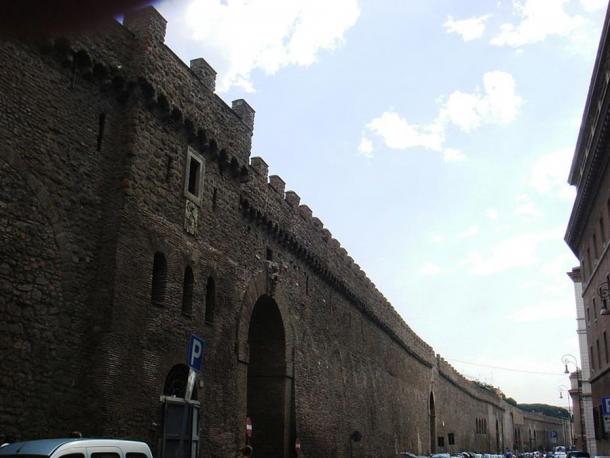Guest
Guest
 |  Subject: The Passetto: Escape Route of Popes in Times Past Subject: The Passetto: Escape Route of Popes in Times Past  Sat Jun 25, 2016 9:06 pm Sat Jun 25, 2016 9:06 pm | |
| 
26 JUNE, 2016 - 00:52 ANCIENT-ORIGINSThe Passetto: Escape Route of Popes in Times Past(Read the article on one page)
The Passetto di Borgo (also known simply as the Passetto, which may be translated as a small passage ) is a corridor that connects the Vatican City, more specifically St. Peter’s Basilica, with the Castel Sant’ Angelo. This passageway is found on top of the old Vatican wall, and was used by the popes as a secret escape route in times of trouble. One of the most well-known incidents when the Passetto was used happened in 1527, when Rome was sacked, and the pope, Clement VII, was forced to flee from his residence to the safety of the Castel Sant’ Angelo via this secret passageway.
    
Old WallThe walls on which the Passetto was built on is said to date back to the second half of the 6 thcentury AD. In 576, the king of the Ostrogoths, Totila, had taken Rome, and decided to build a low wall by the tomb of Hadrian, linking it to the city walls built by Aurelian three centuries before. Additionally, the tomb was transformed into a fortress. This ancient wall, however, crumbled shortly after, and only a few stone blocks of this structure has survived till this day.Totila razes the walls of Florence: illumination from the Chigi ms of Villani's Cronica. ( Public Domain )
New WallConstruction of a new wall began following the coronation of Charlemagne as Emperor by Pope Leo III in 800 AD. As Rome was considered the religious capital of his empire, Charlemagne ordered that a wall be built to defend the tomb of St. Peter. It seems that this wall too did not last long, as the people of Rome tore it down shortly after the death of Leo III in 816. The people of the city were fearful that should the Castel Sant’ Angelo be turned into a new center of power under the rule of the pope and the emperor, Rome’s autonomy would be eroded.

The Passetto. Photo source: ( Public Domain )
As St. Peter’s Basilica lacked a defensive wall, it was easily attacked by Saracen pirates on two occasions, the first being in 830, whilst the second took place 16 years later. By comparison, the rest of Rome was effectively protected from the pirates by the walls built by Aurelian. As a result of these attacks, Pope Leo IV, who is claimed to have been urged by the emperor, Lothair I, had a defensive wall built around the basilica and its grounds around 850. This wall measured about 3 km (1.8 mi) in length, and had 44 towers.
- The Spirit of Beatrice Cenci - A Tale of Terrible Injustice in Ancient Rome
- Pope Joan: The Female Pope whose Real Gender was Revealed after she Gave Birth in a Procession
- Caterina Sforza: A Renaissance Warrior Woman That Knew How to Get What She Wanted
The view from Castel Sant'Angelo towards Vatican City where the wall can be seen. ( CC BY 3.0 )
Permanent Wall ConnectionsThe Passetto was not part of Leo IV’s design, and was a later addition. It was in 1377, after the popes’ return to Rome following their self-exile in Avignon, France, that the idea of the Passetto was conceived. The popes realized that a connection between their residence and the Castel Sant’ Angelo was important, should they need to flee to safety. Thus, it was Pope Nicholas III, who reigned between 1277 and 1280, who had the first walkway built on top of the portion of the wall that connected St. Peter’s Basilica and the Castel Sant’ Angelo. Some further alterations were carried out by Pope Alexander VI towards the end of the 15 th century.Pope Nicholas III Cameo (Public Domain )
Sack of RomeThe Passetto was most famously used by Pope Clement VII when Rome was sacked in 1527. On May 6 of that year, the landsknecht, who were German mercenaries, entered and sacked Rome. These mercenaries were based in the north of Italy, and were threatening mutiny due to a lack of provisions and pay.Sebastiano del Piombo (Italian) - Pope Clement VII. (Public Domain )
Although a sum of 100,000 ducats was paid, the landsknecht nevertheless marched against Rome. They arrived before the city walls on the 5 th of May, which were left almost undefended, as an attack from this army was not expected. For eight days, Rome was sacked. The pope, however, survived, as he was led by the Swiss Guard across the Passetto to the safety of the Castel Sant’ Angelo. Of the 189 Swiss Guards on duty that day, only 42 survived.
|
|





